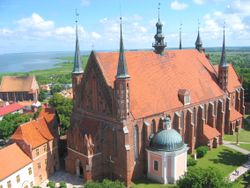Diocese of Warmia
|
Archdiocese of Warmia Archidioecesis Varmiensis Archidiecezja warmińska Erzdiözese Ermland |
|
|---|---|

Frombork Cathedral, with Vistula Lagoon in background.
|
|
| Location | |
| Country | Poland |
| Ecclesiastical province | Province of Warmia |
| Statistics | |
| Area | 12,000 km2 (4,600 sq mi) |
| Population - Total - Catholics |
(as of 2014) 711,000 694,000 (97.6%) |
| Information | |
| Denomination | Roman Catholic |
| Rite | Latin Rite |
| Established | 13th Century (As Diocese of Warmia) 25 March 1992 (As Archdiocese of Warmia) |
| Cathedral | Basilica of the Assumption of the Blessed Virgin Mary in Frombork |
| Co-cathedral | Basilica of Saint James the Apostle in Olsztyn |
| Current leadership | |
| Pope | Francis |
| Metropolitan Archbishop |
Józef Górzyński, Archbishop of Warmia |
| Emeritus Bishops |
Edmund Michał Piszcz, Archbishop Emeritus of Warmia Wojciech Ziemba, Archbishop Emeritus of Warmia Julian Andrzej Wojtkowski, Auxiliary Bishop Emeritus of Warmia |
| Website | |
| archidiecezjawarminska.pl | |
The Roman Catholic Archdiocese of Warmia (Polish: Archidiecezja warmińska, German: Erzdiözese Ermland) is an archdiocese of the Latin Rite of the Roman Catholic Church in Poland. About 29.4% of its population went to church at least once per week in 2013.
The Archdiocese contains a population of around 700,000. The archbishop has two seats: one is located in the town of Frombork and the other in the city of Olsztyn.
The current Archbishop is Józef Górzyński, who was appointed by Pope Francis in 2016.
Founded as the Diocese of Ermland on 29 July 1243, it was one of the four bishoprics of the State of the Teutonic Order in Prussia. The first bishop Heinrich von Strateich never actually took his office. His successor Anselm of Meissen, officiating between 1250 and 1274, became the first bishop active in Ermland. In 1253, after Albert Suerbeer finally achieved his long disputed investiture with the newly elevated Archbishopric of Riga, Ermland - like a number of other Baltic dioceses - became Riga's suffragan. Ermland's first bishops were appointed by Polish and Teutonic Knights' officials and were mostly Germans, however, unlike the other Prussian bishoprics (Culm, Pomesania, and Samland), Ermland's diocesan chapter, established in 1260, maintained independence. Its members were not simultaneously members of the Teutonic Order, as was the case in the other Prussian chapters since the 1280s. Thus the chapter could repel influencing by outside powers.
...
Wikipedia
